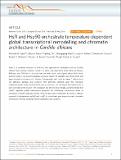| dc.contributor.author | Leach, Michelle D. | |
| dc.contributor.author | Tan, Kaeling | |
| dc.contributor.author | Miao, Zhengqiang | |
| dc.contributor.author | Walker, Louise A. | |
| dc.contributor.author | Cuomo, Christina A. | |
| dc.contributor.author | Wheeler, Robert T. | |
| dc.contributor.author | Brown, Alistair J. P. | |
| dc.contributor.author | Wong, Koon Ho | |
| dc.contributor.author | Cowen, Leah E. | |
| dc.contributor.author | Farrer, Rhys | |
| dc.date.accessioned | 2017-09-18T15:38:54Z | |
| dc.date.available | 2017-09-18T15:38:54Z | |
| dc.date.issued | 2016-05 | |
| dc.date.submitted | 2015-12 | |
| dc.identifier.issn | 2041-1723 | |
| dc.identifier.uri | http://hdl.handle.net/1721.1/111593 | |
| dc.description.abstract | Fever is a universal response to infection, and opportunistic pathogens such as Candida albicans have evolved complex circuitry to sense and respond to heat. Here we harness RNA-seq and ChIP-seq to discover that the heat shock transcription factor, Hsf1, binds distinct motifs in nucleosome-depleted promoter regions to regulate heat shock genes and
genes involved in virulence in C. albicans. Consequently, heat shock increases C. albicans host cell adhesion, damage and virulence. Hsf1 activation depends upon the molecular chaperone Hsp90 under basal and heat shock conditions, but the effects are opposite and in part controlled at the level of Hsf1 expression and DNA binding. Finally, we demonstrate that Hsp90 regulates global transcription programs by modulating nucleosome levels at promoters of stress-responsive genes. Thus, we describe a mechanism by which C. albicans responds to temperature via Hsf1 and Hsp90 to orchestrate gene expression and chromatin architecture, thereby enabling thermal adaptation and virulence. | en_US |
| dc.language.iso | en_US | |
| dc.publisher | Nature Publishing Group | en_US |
| dc.relation.isversionof | http://dx.doi.org/10.1038/ncomms11704 | en_US |
| dc.rights | Creative Commons Attribution 4.0 International License | en_US |
| dc.rights.uri | http://creativecommons.org/licenses/by/4.0/ | en_US |
| dc.source | Nature | en_US |
| dc.title | Hsf1 and Hsp90 orchestrate temperature-dependent global transcriptional remodelling and chromatin architecture in Candida albicans | en_US |
| dc.type | Article | en_US |
| dc.identifier.citation | Leach, Michelle D. et al. “Hsf1 and Hsp90 Orchestrate Temperature-Dependent Global Transcriptional Remodelling and Chromatin Architecture in Candida Albicans.” Nature Communications 7 (May 2016): 11704 | en_US |
| dc.contributor.department | Broad Institute of MIT and Harvard | en_US |
| dc.contributor.department | Massachusetts Institute of Technology. Department of Biology | en_US |
| dc.contributor.mitauthor | Farrer, Rhys | |
| dc.relation.journal | Nature Communications | en_US |
| dc.eprint.version | Final published version | en_US |
| dc.type.uri | http://purl.org/eprint/type/JournalArticle | en_US |
| eprint.status | http://purl.org/eprint/status/PeerReviewed | en_US |
| dspace.orderedauthors | Leach, Michelle D.; Farrer, Rhys A.; Tan, Kaeling; Miao, Zhengqiang; Walker, Louise A.; Cuomo, Christina A.; Wheeler, Robert T.; Brown, Alistair J. P.; Wong, Koon Ho; Cowen, Leah E. | en_US |
| dspace.embargo.terms | N | en_US |
| dc.identifier.orcid | https://orcid.org/0000-0002-3710-9881 | |
| mit.license | PUBLISHER_CC | en_US |
| mit.metadata.status | Complete | |
